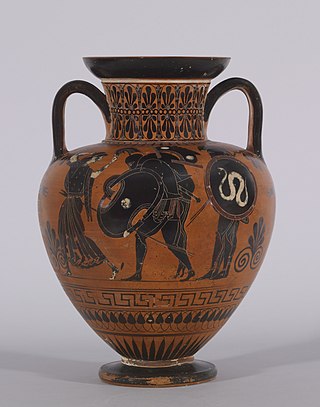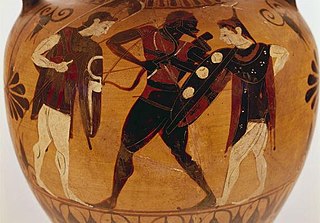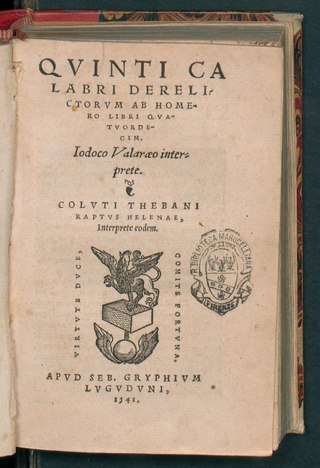Bibliography
- West, Martin L. Greek Epic Fragments. Cambridge, Massachusetts: Harvard University Press, 2003.
The Cyclic Poets is a shorthand term for the early Greek epic poets, who were approximate contemporaries of Homer. No more is known about those poets than about Homer, but modern scholars regard them as having composed orally, as did Homer. In the classical period, surviving early epic poems were ascribed to those authors, just as the Iliad and Odyssey were ascribed to Homer. Together with Homer, whose Iliad covers a mere 50 days of the war, they cover the complete war "cycle", thus the name. Most modern scholars place Homer in the 8th century BC. The other poets listed below seemed to have lived in the 7th to the 5th centuries BC. Excluding Homer's, none of the works of the cyclic poets has survived.

In Greek mythology, Achilles or Achilleus was a hero of the Trojan War, the greatest of all the Greek warriors, and the central character of Homer's Iliad. He was the son of the Nereid Thetis and Peleus, king of Phthia.

Ajax or Aias is a Greek mythological hero, the son of King Telamon and Periboea, and the half-brother of Teucer. He plays an important role in the Trojan War, and is portrayed as a towering figure and a warrior of great courage in Homer's Iliad and in the Epic Cycle, a series of epic poems about the Trojan War, being second only to Achilles among Greek heroes of the war. He is also referred to as "Telamonian Ajax", "Greater Ajax", or "Ajax the Great", which distinguishes him from Ajax, son of Oileus, also known as Ajax the Lesser.

The Dorians were one of the four major ethnic groups into which the Hellenes of Classical Greece divided themselves. They are almost always referred to as just "the Dorians", as they are called in the earliest literary mention of them in the Odyssey, where they already can be found inhabiting the island of Crete.

In ancient Greek religion and mythology, Iris is a daughter of the gods Thaumas and Electra, the personification of the rainbow and messenger of the gods, a servant to the Olympians and especially Queen Hera. Iris appears in several stories carrying messages from and to the gods or running errands but has no unique mythology of her own. Similarly, very little to none of a historical cult and worship of Iris is attested in surviving records, with only a few traces surviving from the island of Delos. In ancient art, Iris is depicted as a winged young woman carrying a caduceus, the symbol of the messengers, and a pitcher of water for the gods. Iris was traditionally seen as the consort of Zephyrus, the god of the west wind and one of the four Anemoi, by whom she is the mother of Pothos in some versions.
Arctinus of Miletus or Arctinus Milesius was a Greek epic poet whose reputation is purely legendary, as none of his works survive. Traditionally dated between 775 BC and 741 BC, he was said to have been a pupil of Homer. His father was Teleus son of Nauteus. Phaenias of Eresus placed him in the 7th century BC and claimed that he was defeated by Lesches of Pyrrha in competition. One of the "cyclic poets", Arctinus composed the epics Aethiopis and Sack of Troy, which were contributions to the Trojan War cycle, and possibly Naupactia.
The Little Iliad is a lost epic of ancient Greek literature. It was one of the Epic Cycle, that is, the Trojan cycle, which told the entire history of the Trojan War in epic verse. The story of the Little Iliad comes chronologically after that of the Aethiopis, and is followed by that of the Iliou persis. The Little Iliad was variously attributed by ancient writers to Lesches of Pyrrha, Cinaethon of Sparta, Diodorus of Erythrae, Thestorides of Phocaea, or Homer himself. The poem comprised four books of verse in dactylic hexameter, the heroic meter.
The Telegony is a lost ancient Greek epic poem about Telegonus, son of Odysseus by Circe. His name is indicative of his birth on Aeaea, far from Odysseus' home of Ithaca. It was part of the Epic Cycle of poems that recounted the myths of the Trojan War as well as the events that led up to and followed it. The story of the Telegony comes chronologically after that of the Odyssey and is the final episode in the Epic Cycle. The poem was sometimes attributed in antiquity to Cinaethon of Sparta, but in one source it is said to have been stolen from Musaeus by Eugamon or Eugammon of Cyrene. The poem comprised two books of verse in dactylic hexameter.
The Cypria is a lost epic poem of ancient Greek literature, which has been attributed to Stasinus and was quite well known in classical antiquity and fixed in a received text, but which subsequently was lost to view. It was part of the Epic Cycle, which told the entire history of the Trojan War in epic hexameter verse. The story of the Cypria comes chronologically at the beginning of the Epic Cycle, and is followed by that of the Iliad; the composition of the two was apparently in the reverse order. The poem comprised eleven books of verse in epic dactylic hexameters.
Homeric Greek is the form of the Greek language that was used in the Iliad, Odyssey, and Homeric Hymns. It is a literary dialect of Ancient Greek consisting mainly of Ionic, with some Aeolic forms, a few from Arcadocypriot, and a written form influenced by Attic. It was later named Epic Greek because it was used as the language of epic poetry, typically in dactylic hexameter, by poets such as Hesiod and Theognis of Megara. Compositions in Epic Greek may date from as late as the 5th century CE, and it only fell out of use by the end of classical antiquity.

In Greek mythology, Memnon was a king of Aethiopia and son of Tithonus and Eos. As a warrior he was considered to be almost Achilles' equal in skill. During the Trojan War, he brought an army to Troy's defense and killed Antilochus, Nestor's son, during a fierce battle. Nestor challenged Memnon to a fight, but Memnon refused, being there was little honor in killing the aged man. Nestor then pleaded with Achilles to avenge his son's death. Despite warnings that soon after Memnon fell so too would Achilles, the two men fought. Memnon drew blood from Achilles, but Achilles drove his spear through Memnon's chest, sending the Aethiopian army running. The death of Memnon echoes that of Hector, another defender of Troy whom Achilles also killed out of revenge for a fallen comrade, Patroclus.

The Posthomerica is an epic poem in Greek hexameter verse by Quintus of Smyrna. Probably written in the 3rd century AD, it tells the story of the Trojan War, between the death of Hector and the fall of Ilium. The poem is an abridgement of the epic poems Aethiopis and Iliou Persis by Arctinus of Miletus and the Little Iliad by Lesches, all now-lost poems of the Epic Cycle.

Ancient accounts of Homer include numerous passages in which archaic and classical Greek poets and prose authors mention or allude to Homer. In addition, they include the ten biographies of Homer, often referred to as the Lives.

In Greek mythology, the Hecatoncheires or Hekatoncheires, or Hundred-Handers, also called the Centimanes were three monstrous giants, of enormous size and strength, each with fifty heads and one hundred arms. They were individually named Cottus, Briareus and Gyges. In the standard tradition they were the offspring of Uranus (Sky) and of Gaia (Earth), and helped Zeus and the Olympians to overthrow the Titans in the Titanomachy.

The Iron Age Greek migrations were effected by a population of émigrés from amidst the displacements and reconstruction that occurred in Greece proper from the middle of the 11th century to the end of the 9th century BCE. The movements resulted in the settlement of the Aegean islands, Cyprus, Crete and the western coast of Asia Minor and the founding of new cities, which afterwards became centers of the Greek civilization. The migrations by various tribal groups were effected in consecutive waves known as the Aeolic, Ionian, Doric and Achaean (Arcadian) migrations. The movements differed from the Greek colonisation of the Archaic period in that they were more ad hoc affairs, rather than being the result of a planned process of colonisation on the part of the mother city. They are also less well-documented historically and in folk histories are often said to have been led by a mythologized or semi-legendary leader, such as Hercules or Orestes.
This page lists topics related to ancient Greece.